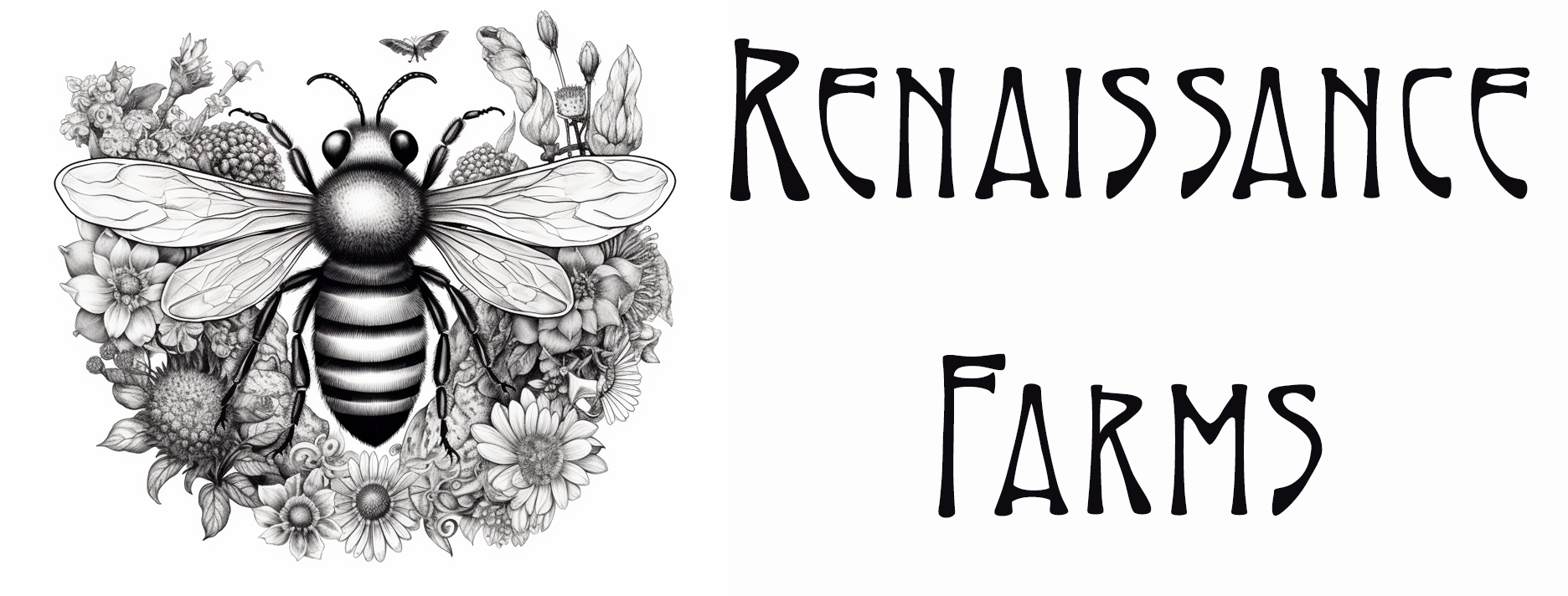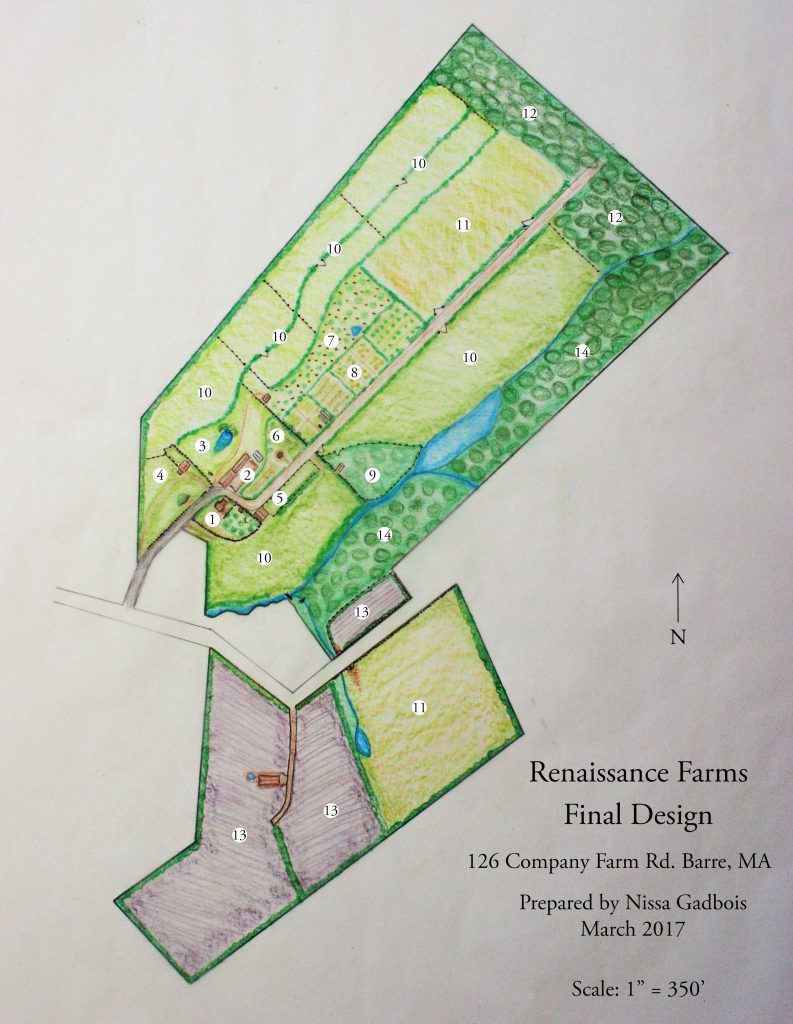Since purchasing the farm in 2011, the Gadbois family have been striving toward a model of permaculture for the farm. In March 2017, the conceptual design for Renaissance Farms was completed and we are now in the first phase of implementation.
Our mission is to develop a permaculture farm site that will serve the community with nutritious, locally grown and raised foods; with education ranging from nutrition and traditional medicine to practical skills in natural building, handcrafts, and permaculture farming; and with spiritual nourishment and refreshment in the Catholic tradition.
Permaculture is a system of integrated design. Primarily, it was a set of principles to guide the design of farms and homesteads to work in harmony with the natural world. Since then, it has grown to include systems of community and organizational design. We care for the Earth, our common home. We care for people, the ones who work and volunteer and learn here as well as those who visit here and those whom we serve with the produce of our farm. And give back by producing as little waste as possible and sharing with wildlife, improving the soil, and feeding those who struggle to feed themselves and their families well.
For more information about what permaculture is, please visit our event page to sign up for a free talk: Introduction to Permaculture, or sign up for our mailing list for more information on permaculture classes and projects to participate in. And please consider backing one of our fundraising campaigns that will supply materials and student scholarships for our permaculture projects.
Below is the design for our farm:
ZONE ONE
- Home– This area is detailed on the Zone One Design. In addition, there is a garden to the east of the home where there will be a natural play area for our children, a writer’s cottage, and orchard trees. The southern margin of this area will be a poppy field for beauty as well as fodder for bees and other insects.
- Multipurpose Building – This area includes space for our farm shop and bistro, indoor gathering space, overnight accommodation for guests and WWoofers, workshops (chandlery, woodshop, spinnery), and a glasshouse, as well as ample parking.
ZONE TWO
- Small Scale Aquaculture – The existing pond will be expanded to about twice its current size and will be home to a variety of fish as well as edible aquatic and marginal plants. The grassy perimeter will be home to our egg laying hens.
- Sheep Barn and Dairy – This barn will house up to 200 Icelandic sheep that will provide the farm with milk, wool, meat, skins, and horn. Attached to the barn will be a dairy. Hay storage and farmhand apartment will be located on the second floor. A short distance from the barn will be an earth bermed aging cave for our cheeses and charcuterie.
- Horse Barn – The barn will shelter up to six working horses and their equipment and tack. A lean-to on the south wall will cover our tractor and implements. Hay storage and farmhand apartment will be located on the second floor.
- Herb Garden – this three-acre area is where we will grow medicinal and culinary herbs, plants for natural dye, and flowers for cutting. There will also be a 30’ gazebo for outdoor gatherings and classes.
- Orchard Apiary – Approximately 5 acres of heirloom fruit trees will be planted and give shelter to our large apiary. A 1500 -2000 sq. ft. building will be built on an existing foundation. This is where we will process honey, maintain hives, separate wax and other bee products and perhaps also have a cidery. The sheep will occasionally offer mowing services here without disturbing the bees.
- Market Gardens – Ranging from potager to row cropping in style, these four parcels will equal around 6 acres. We will grow a variety of heirloom vegetables and perennial soft fruits. These will supply our customers as well as our on-site catering. We will also use them to demonstrate companion planting, crop rotation, and how permaculture can be applied to a back-yard vegetable patch right up to market gardens like ours.
- Forested Sows and Piglets – This area will shelter our farrowing and nursing sows and their piglets. When the piglets have weaned, they will be moved to the managed woodland at the back edge of the farm. This location provides us with better opportunity to keep a close eye on farrowing sows and the piglets.
ZONE THREE
- Pasture – Our Icelandic sheep, horses, and our tenant’s cattle will graze here in season. The pasture will be mixed with the primary forage as sainfoin as it grows back quickly, has an excellent protein content, and blooms 2-3 times a year, providing fodder for the nearby apiary. Hedge belts will be planted on the western pastures in swales on contour to help combat some erosion and offer a lovely spot out of the wind. The sheltered side of the hedge will be planted with additional herbs and interesting forages for animals. Hedges will provide shelter and food for the wildlife as well as more food for the bees. There will be fencing to separate the paddocks, allowing us to rotate the livestock through. Initially, we will use temporary fencing, later perhaps permanent fencing with gates.
ZONE 4
- Hayfields – Approximately 40 acres of hay will supply us with up to 12,000 bales of hay each year – more than enough for our needs. The rest will be sold on to area farms for their needs, or used as mulch. The hay mix will contain roughly the same mix as our summer pastures.
- Managed Woodland – we will plant a variety of hardwood species here with an emphasis on black and honey locust for roundwood and poles. Beneath the trees, we will put out heritage breed pigs (Gloucester Old Spot, Large Black, Berkshire, and/or Tamworth) to forage and shelter. We have found that pigs are excellent guardian animals and will be well placed to keep coyotes from entering from the neighbouring State Forest and disturbing our more vulnerable livestock. The pigs will happily grub up all sorts of food from the forest floor, eat snakes, rats, and toads. They will be treated to scraps from the market gardens and orchard, as well as supplemental feeds through our co-op. They will be raised for meat and fat. Our oldest son will make charcuterie on farm from them.
- Lavender Fields – We have already begun growing lavender here, in the smallest field shown. We will add several more varieties including those for culinary, cutting, and perfumery. In the field furthest south and west, along the farm road, we will build a facility for drying the harvest and distilling buds for oil and hydrosol. The waste will be used as compost, or to strew around buildings to deter pests. Between the rows of lavender, we will grow a cover crop of clover and cleavers. Geese will be grazed rotationally between the rows. We will use their meat and schmaltz, eggs, and feathers. The hedges separating and encircling the fields will include damask rose which will also be distilled for oil and hydrosol.
ZONE FIVE
- Woodland – it is our intention to leave this woodland untouched as a place of shelter and safe passage for wildlife that includes coyote, black bear, bobcat, fox, moose, whitetailed deer, fishercat, beaver, various hawks and eagles, and many, many more. Zone five also includes the northwestern perimeter of the farm.

